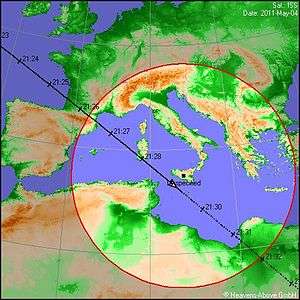Heavens-Above
Heavens-Above is a non-profit website developed and maintained by Chris Peat as Heavens-Above GmbH. The web site is dedicated to helping people observe and track satellites orbiting the Earth without the need for optical equipment such as binoculars or telescopes. It provides detailed star charts showing the trajectory of the satellites against the background of the stars as seen during a pass. Special attention is paid to the ISS, Starlink satellites and other. Space shuttle missions were tracked until the program was retired in July 2011 and Iridium flares were also tracked until the program was retired in May 2018. The website also offers information on currently visible comets, asteroids, planet details, and other miscellaneous information.
 Heavens-Above home page | |
| Available in | Multilingual |
|---|---|
| Owner | Chris Peat |
| Created by | Chris Peat |
| URL | heavens-above |
| Alexa rank | 63,829 (as of March 2012)[1] |
| Current status | Active |
Sky & Telescope magazine described Heavens-Above as "the most popular website for tracking satellites."[2]
Users click on a map of the world to set their viewing location. Lists of objects, their brightness and the time and direction to look to see those objects are given. Space stations, rockets, satellites, space junk as well as Sun, Moon, and planetary data are given.
The authors also offer a freeware mobile app that shows similar information for the user's location.[3]

See also
References
- "heavens-above.com Site Info". Alexa Internet, Inc. Retrieved 17 March 2012.
- Beatty, J. Kelly (July 23, 2006). "Take a 'Sat-seeing' Tour". Sky & Telescope. Retrieved 17 March 2012.
- "Heavens Above App Review: Precise pass predictions for the ISS, visible satellites". www.starmapping.co.uk. Retrieved 2016-12-11.